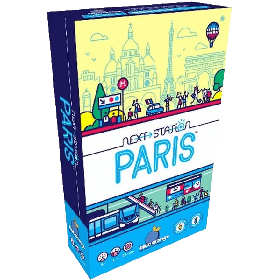nextstationparis
 Become the best metro network planner Paris has
ever seen.
Become the best metro network planner Paris has
ever seen.
Use overhead crossings to link the capital’s
iconic monuments, all while optimising shortcuts
through the central platform!
Niver a c'hoarierien: 1 - 4
Padelezh ar bartienn: 9 mn
Kemplezhded : 2 / 5
C'hoari da nextstationparis pe da 992 c'hoari all enlinenn.
Pellgargañ ret ebet - c'hoariit war-eeun adalek ho merdeer.
Gant ho mignoned ha miliadoù c'hoarierien/ezed en hollved.
Evit netra.

C'hoari da nextstationparis pe da 992 c'hoari all enlinenn.
Pellgargañ ret ebet - c'hoariit war-eeun adalek ho merdeer.
Gant ho mignoned ha miliadoù c'hoarierien/ezed en hollved.
Evit netra.

Diverradenn ar reolennoù
Goal: Create a great tourist subway map and score the most points in Paris. If you played Next Station London or Next Station Tokyo, the basics are the same, but there are several differences.
Overview
The game is played over 4 rounds, one for each subway line that players are drawing on their map sheets.
During a round, 5-10 cards will be flipped from the common station deck (which comprises 11 cards: 5 with blue and green background, the rest are yellow). Each station card lets each player add a line segment onto their current subway line, if possible (but a player may always pass if they choose). (See below for the construction rules.)
At the end of each round, the subway line each player drew is scored (see below for scoring), the station deck is reshuffled, and players start drawing a new subway line. Best score wins!
How to play
Flipping cards
Each turn, a card with one of four symbols will flip up. All players will draw a straight line from their starting point to a station with this symbol, following one of the dotted guides on the board. (Note players will see the same symbol, but each has a different starting point.) If a wild symbol flips, you can pick any symbol for that station, and players don't need to pick the same symbol. Also note that drawing a new subway route is always optional; you can skip any flip of a card if you want to.
Starting a new round
Continue this way until all five of the cards with blue and green background have been flipped and resolved -- note this means each round will have 5 to 10 turns. When the new round begins, start the next subway line from the next starting point. Keep going until all 4 subway lines have been filled in.
Rules for drawing lines
- A subway line segment can only be drawn on the straight dashed grey lines, cannot bend, and connects exactly two stations (you can never pass through one to reach a further one).
- Each segment must connect to one of the two ends of the current line (unless the Railroad Switch card appears, which permits a segment to connect anywhere along the current line). If this is the first card of the round, the segment must connect to the Departure station for that line (these stations are denoted on the Map sheet with the line colors).
- Subway lines can't cross themselves or another line -- unless you are using the overhead crossing (see below).
- While a subway line can't revisit the same station (intersect itself); different train lines can visit the same station. (A station with multiple lines is called an interchange, and can score extra points!)
- A given segment on your sheet may not be drawn more than once.
Special Features
Overhead Crossings
Overhead crossings are where a bridge allows one line to cross over another potential railway line. Only at these points may two lines cross each other. Bonus points are awarded for lines that go through overhead crossings (see scoring).
Central Station
In the centre of the map is the central station, with all four symbols on it. A line may be drawn to this station whatever symbol is showing on the card.
Special Cards
Free Entry or Guided Tour
This wild card permits a section to be drawn to the player's choice of station. If the section goes to a monument, then an additional section may be drawn from the monument to a station of the player's choice.
Railroad Switch
Typically your new line segment must always continue from the station on either end of your track. However if a Railroad Switch card is drawn, you may draw a new line segment from any station in that round's subway track, possibly producing an additional end to use in a future round. (Note that if the Railroad Switch is flipped first or second, it will have no effect.)
Scoring
Line scoring
Each line scores separately. To score a line, count the number of districts it passes through. (Districts are regions separated by yellow lines.) Then multiply this by the number of stations visited by this line in one specific district -- whichever district has the most stations for this line. Then add two points for each Parisian monument visited by the line. For example, if a line visits 5 districts, and 3 stations in one district, and visits two Parisian monuments, then that line scores (5 x 3) + 4 = 19 points. Then repeat this same process for each other lines, and add these line scores together.
Interchange and Overhead Crossing scoring
An interchange is a station that is visited by more than one color line. Each 2 line, 3 line, or 4 line interchange scores 2, 5, or 9 points respectively.
Each level crossing also scores points. 2 points for each level crossing that has one line running through it. 6 points for each level crossing that has 2 lines running through it.
Objectives
If playing with objectives, each player scores 10 points per objective they completed.


